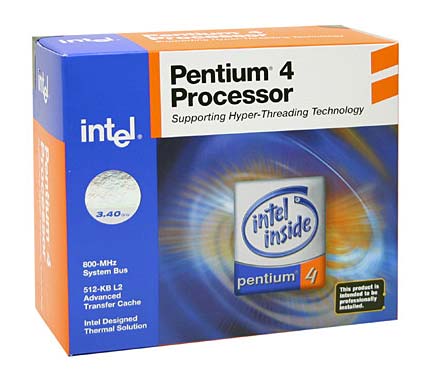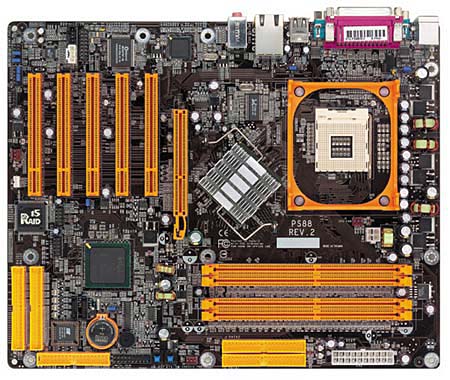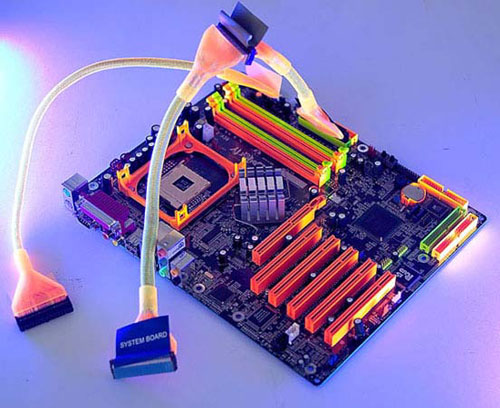Buyer's Guide: High End System - May 2004
by Wesley Fink on May 26, 2004 11:00 AM EST- Posted in
- Guides
CPU and Motherboard Alternatives
CPU: Intel Pentium 4 3.4C (512K L2 cache) NorthwoodMotherboard: DFI (875P chipset)
Price: CPU - $416 shipped (retail heatsink and fan). Motherboard - $174 shipped

Despite the fact that cost is a secondary concern in recommendations for a High End system, it is still difficult to recommend the $1100 3.4GHz Pentium4 EE when the 3.4GHz P4C (Northwood) is 60% less with the same core and 512KB cache instead of 2.5MB. 250% seems a hefty premium for the extra cache when the impact on performance is fairly small. If you want the bragging rights that come with the top Intel CPU, then get the P4EE, but the 3.4C is our recommendation at about the same price as the AMD Athlon 64 3400+. Both offer similar performance in today's applications depending on exactly which applications you use. For Desktop Applications, the 3.4C and 3400+ are virtually equal. If you do a lot of encoding, then the pendulum tilts toward the 3.4C over the 3400+ for now. If you're a gamer, the Athlon 64 3400+ is a better performer in most games. If 64-bit capabilities matter to you, then the AMD Athlon 64 is your only option. We suggest that you research which processor fits you best. A good place to start is at AnandTech's latest CPU article.
One advantage of a Pentium 4 is Hyper Threading, which makes a single processor behave like two multiple processors in some ways. Hyper Threading can increase performance substantially in multi-tasking situations, but the impact is less noticeable as clock speed increases. In today's applications, HT does not offer much benefit, though this may change in some future applications.
Intel seemed to design their labeling system to utterly confuse the buyer, so it is worth some efforts to clear the misunderstandings. An Intel Pentium 4 labeled with a "C" after its core clock speed (3.4C, in this case) is based on the Northwood core, has 512K of L2 cache, and is built on (mostly) 0.13-micron technology. A Pentium 4 labeled with an "E" after its core clock speed (3.4E for example) is based on the Prescott core, has 1MB of L2 cache, and is built on (mostly) 0.09-micron technology. Finally, a Pentium 4 labeled with an "EE" after its core clock speed (3.4EE, for example) is based on the Northwood core, has 512K of L2 cache plus 2MB of L3 cache, and is built on (mostly) 0.13-micron technology. The C, E, and EE Pentium 4 processors all run at 800MHz FSB and are dual channel DDR capable. While the future for Intel is slated to be the Prescott CPU, the slower speed and heat make the Prescott a difficult choice over the Northwood at current speeds. Performance becomes less an issue as speed increases and the heat issue is also improving. Next month's Socket 775 CPU from Intel will be Prescott-based and we have already seen that Prescott optimizations in the chipset can provide a big boost on Prescott Performance. The point here is this: Intel is constantly refining the Prescott, as they did with the original Pentium 4, so Prescott must be considered a work-in-progress that is getting better every day.
One of the most amazing turnarounds in the computer industry has been DFI. The large OEM partner decided to go after the enthusiast market with their own brand and transformed themselves from "Diamond Flower International" into "Designed For Innovation". It takes real performance to achieve this kind of transition and DFI has delivered this in spades in their LAN Party motherboard series.

The LAN Party 875B is an excellent and flexible home for a 3.4C, particularly in the latest Rev. B version. The Asus P4C800-E and DFI 875B LAN Party seems to make every recommended list as the top two motherboards for Intel enthusiasts because they are both solid performers at stock speeds and they both are capable of incredible performance with the fastest memory and Intel processors on the market. Our nod for top end system goes to the DFI because high end systems should stand out in some way, such as incredible performance or incredible looks. The DFI has both and you certainly will notice this motherboard as it is also unique to look at, particularly under black light. The 875B LAN Party also does the eye-candy trick without giving up anything in performance or flexibility.

While the price of the DFI is toward the high end, it includes matching glowing cables, a Front-X box for front ports, and a PC Transport to carry your PC. All these features would cost quite a bit extra if you had to buy them on the side, so there is definitely value in the DFI 875B. If the extras don't matter much to you, the same basic board is available as the DFI 875P Infinity for about $40 less. Revision B of the DFI has a greater range of adjustments than the original LAN Party and it also sports CMOS reloaded, a unique feature allowing several custom BIOS setups to be saved and selected in CMOS. All the top-end features are here with the notable exception of Firewire, so if you require Firewire, choose another board or add a Firewire PCI card. In addition to all the high-end goodies in the LAN Party box, there is an impressive feature list that includes Intel SATA RAID, Intel Gigabit CSA LAN, High Point 4-device IDE RAID supporting RAID 0, 1, 0+1, and 1.5 (a method to stripe and mirror using just 2 drives), 6-channel audio featuring the CMedia CMI9739A chip and a SPDIF IO bracket, and 8 USB 2.0 ports. End users who own the 875 LAN Party tell us that it is bullet-proof and one of the most stable motherboards they have ever owned - always a great recommendation for a high end motherboard.
Listed below is part of our RealTime pricing engine, which lists the lowest prices available on the Intel CPUs and motherboards from many different reputable vendors:
If you cannot find the lowest prices on the products that we've recommended on this page, it's because we don't list some of them in our RealTime pricing engine. Until we do, we suggest that you do an independent search online at the various vendors' web sites. Just pick and choose where you want to buy your products by looking for a vendor located under the "Vendor" heading.










59 Comments
View All Comments
Modal - Thursday, May 27, 2004 - link
RE #25:I just built a system with two 74GB raptors in RAID 0, and I can tell you that they are, surprisingly, not that loud. I'm using a Thermaltake 480W PSU with a fan speed controller; when I have it cranked, I can't hear my hard drives at all. When I have the PSU fan turned down, I can hear them a little, little bit, but its nothing like a 'jet engine.'
KenRico - Thursday, May 27, 2004 - link
#23 and #24 make good points on structure and the $5k target.If the Display Speaker and KB&Mouse are removed it gives alot more latitude in the System Components with the $5k ceiling.
The FX53 is going up +$66 dollars 06/01 a little bird told me. Hopefully the Opteron 150 will remain the same as it is showing at $600ish
Ma10n3 - Thursday, May 27, 2004 - link
Oh, I forgot to clarify something...The reason I said AMD was the obvious choice is that the only motherboards available now with support for AGP 8X, PCI-X, and legacy 32-bit PCI currently only support AMD64. Why? Intel doesn't seem to want us to have it all just yet. AMD's chipsets gives us the technology, now.
Disclaimer: I used to be a die-hard Intel fan, then after doing a little research I found out that AMD is by far the technology leader for the x86, and not just because of the AMD64 chips.
I guess I couldn't stay off my kick for long...
Ma10n3 - Thursday, May 27, 2004 - link
I have to agree with #23. There are a lot of possibilities with a $5,000 limit, and a lot of biases toward certain brands among the readers (Intel or AMD).So, since AMD is the obvious choice for the "Uber" system, what about throwing in an Adaptec 2810SA Hardware RAID controller and setup 8 74/36GB Raptors as one RAID 5 array using hot-swappable bays. Of course, you're going to need a serious case for this as well.
Noise? You can't be concerned with noise when it comes to the "Uber" system. Maybe some sound-dampening measures could be taken, but other than that... Besides, could you imagine the sound of 8 10K RPM raptors all churning together? POWER. SPEED. PERFORMANCE. That's the only mantra for the "Uber" system.
Alright, I'll get off my kick for now...
Frallan - Thursday, May 27, 2004 - link
I love reading your guides I don't always agree on choises but that is not the point is it? Just getting a thought through well argumented article to read in an area where I myself have alot ideas and thoughts is very valueble. So therefore Thx for these guids. (Btw #21 pls read up b4 starting to shout your head off).Now to the issues:
1. Re: the overclocking guide (where I really have an interest) Pls. incl. a top performer kit - means not only the best OC in terms of how OC-able but also a maximum performance OCed kit.
2. Re: The choise of the 10.000 rpm HD:s I have not have the guts to get these drives yet since I have to be in the same room as the box. Just how loud are they in this system? (2*10.000 rpm makes my Jet-enging warning alarm to go off.)
Thx and keep up the good work - you have picked up the slack where other hardware sites have deterioated the last year :).
Mackintire - Thursday, May 27, 2004 - link
Great job on the guide, I really disagreed on Evan's previous choices. You definately are at least in the ballpark. What confuses me is the $5000 limit. If its a $5000 limit you could do alot more, that would be the only gray area I saw. .............................................otherwise Great Job!TrogdorJW - Thursday, May 27, 2004 - link
Welcome to the System Guide section, Wesley. Now you, too, can get lambasted every time you put together an article by people like #21. No complaints from me, though: I understand that there are always choices to be made. However, that said, I really doubt many people will really consider buying a $3000 PC. The $2000 high-end systems of the past were at least potentially affordable. Please try not to go much higher (despite the $5000 "limit").Overall, I really like the recommendations with some explanation of other alternatives. It almost seems like we should have four "high-end" system recommendations, though. One for those where money is no concern, a second for those where money is somewhat a concern, and then double that with AMD systems and Intel systems. (There are people out there that will *never* buy AMD and others that will *never* buy Intel.) So we could get an Athlon FX-53/Dual Opteron 250 system, an Athlon 64 3400+ system, an Intel P4EE/Dual Xeon system, and an Intel P4C/P4E system (depending on how things develop in the future).
Not sure how feasible this is, but it seems like you really only need to list CPU, motherboard, and RAM for the four separate configurations. The remaining components could remain as they are, with two recommendations on each item (the "uber" component, and the "good" component).
And finally, I complained about this on other guides, and the high-end guide certainly deserves this complaint as well: why is there no alternate case/PSU recommendation? Surely the Coolermaster with Antec Truepower 430W isn't the only possibility. I would like to see something more silent as a perhaps more expensive option. A case supporing 120mm fans and/or a fanless PSU might be a nice addition.
Overall, though, great job. It's nice to see things mixed up a little after Evan Lieb's choices. Just don't get too set on the choices each month - maybe you two should alternate on the system guides each month? :)
VagrantZero - Thursday, May 27, 2004 - link
The X800Pro has been shipping for a few weaks now [not in mass quantity but if you want it you can buy it]. It's the XT and 6800U that still hasn't debuted.KenRico - Wednesday, May 26, 2004 - link
Anandtech Rocks...but these guides still don't.Another gentleman already posted but I agree that the OPTERON 148 is a better price/perfomer for the high end. About $20 more than AMD 64 3400+ with Dual Channel action ready to go.
So kind of the guide author to post a video card that is not shipping yet either.
I waded through all the RAM links of "Best Pricing" and the Corsairs specified in the quide are linked below.
I learn nothing from the guides. They specify High End but still look for "value" in onboard NIC ect...then don't post price performance for CPU.
Do we really need a guide to show us an Expensive Processor and Video Adapter?
Where are the benchmarks on this dream system? With no OS quoted this is a collection of parts.
IsThatTheTime - Wednesday, May 26, 2004 - link
I agree with the 200Gb Seagate option, contrary to what was said earlier, they are blisteringly fast compared to their 160Gb and below versions. See Toms Hardware. I just bought four of them for two PCs.Couldn't agree more about the Coolermaster Praetorian, I've two and the solid build quality is breathtaking.....just change all the fans for SilenX one's for a quiet life.
I think a good high end system should have a totally quiet profile too and would suggest the new "Etasis" 0DB! Fanless! PSU (300W) using heatpipe cooling. Totally awesome! and totally quiet. Luxury low environmental noise should come with a luxury £2000 PC.